
In just over 100 years, medicines and medical science moved from relatively primitive treatments based primarily on botanicals and historic recipes, to delivering the modern treatments available today. Just as important is the progress made to regulate and discourage charlatans, hucksters, and fraudsters who profit at the expense of a trusting public. Interested in a career in pharmacy? Learn about pharmacy education and opportunities today.
The lack of regulation or safety oversight for the so-called “Patent” Medicines led to many unnecessary tragedies and deaths. At the turn of the 20th century, there were finally regulations being developed in the US to protect the public.
Looking around Hook’s Drug Store Museum you see large cabinets dedicated to what are called “patent medicines”. They are included in the museum, not as an endorsement, but a true representation of what pharmacies may have stocked in the late 1800s and early 1900s. These potions with clever sounding names and a promise to cure what-ails -you are fun and interesting to behold but fall woefully short on curing anything. If patients were lucky, they weren’t made any worse for ingesting it.
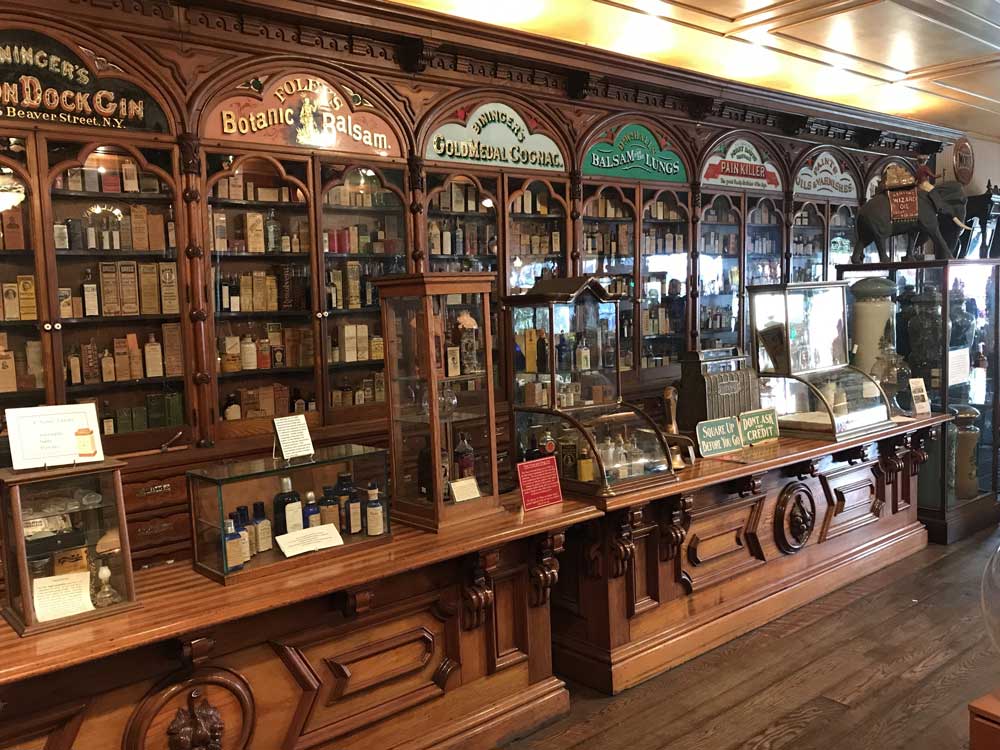
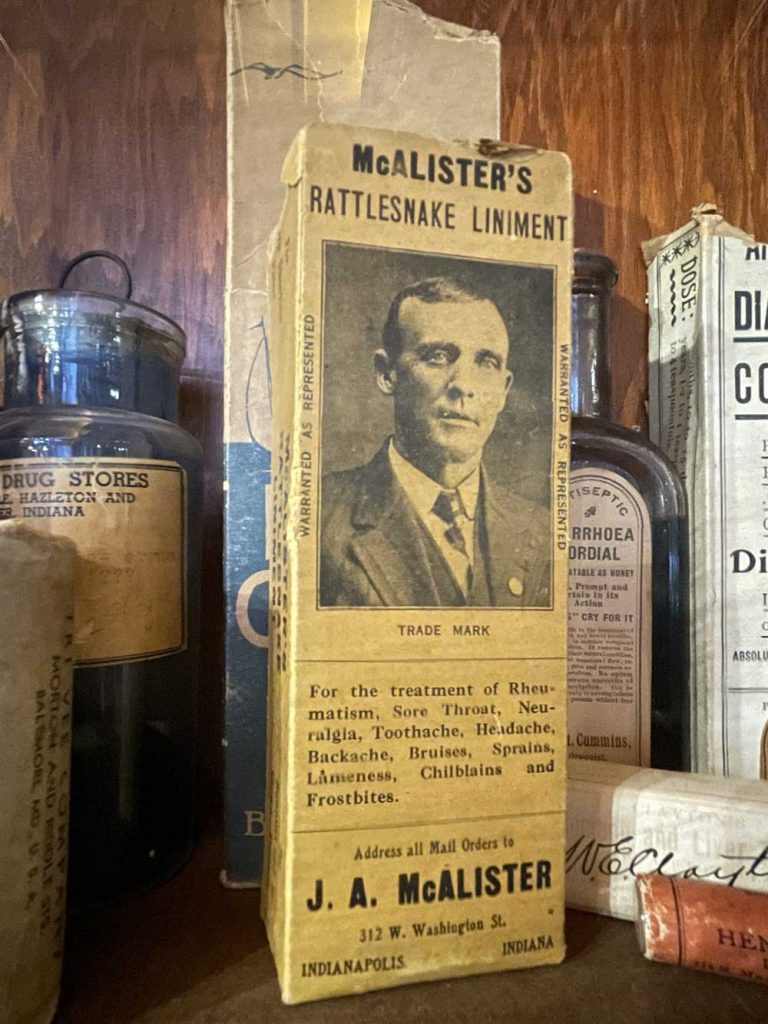
“Patent” medicines originally referred to an old English system that treated medicinal claims similar to the way we think of copyrights for creative ideas. People and companies were allowed to “Patent” particular claims about what their medicines would treat and “cure”, so that no other individual or company could make the same claim, without infringing on their “Patent”, allowing the patent holder to sue the infringer. The “Patent” system for medicines did not exist in the US in the same way, however the name “Patent Medicines” stuck. The great failure of a “Patent” process for medicines was that there was no requirement to prove the medicines actually did what they claimed, or were even safe. Naturally, most did not have any beneficial effect whatsoever, and were at best useless. Ingredients ranged from totally benign but non-beneficial mixtures all the way to ones with powerful narcotics and generous amounts of alcohol, and literal poisons.
Today, Patent Medicine is a euphemism for “Snake-Oil”, a term used to describe quack remedies of unproven effectiveness and questionable safety sold especially by peddlers in past centuries. These were often also called elixirs, tonics, or liniments. Many of these patent medicines ended up on the shelves of pharmacies like Hook’s.
Patent medicines were one of the first major product categories that the advertising industry promoted. Their advertising often marketed products as being medical panaceas and emphasized exotic ingredients and endorsements from purported experts or celebrities, which may or may not have been true. Mostly not.
Some patent medicines did, in fact, deliver the promised results, albeit with very dangerous ingredients. For example, some medicines advertised as “infant soothers” contained opium, then a legal drug. Those advertised as “catarrh snuff” contained cocaine, also legal. Catarrh is an old-time word for the common cold. And many contained a heavy dose of alcohol!
Patent medicines were supposedly able to cure just about everything. Nostrums were openly sold that claimed to cure or prevent constipation, liver disease, kidney issues, venereal diseases, tuberculosis, cancer. cholera, neuralgia, epilepsy, paralysis, hip diseases, chronic abscess, and “female complaints”.
In 1905 and 1906 Collier’s magazine ran a series of influential articles by Samuel Hopkins Adams entitled The Great American Fraud, which exposed many of the deceitful and unsafe methods practiced by patent medicine manufacturers.
Such exposures helped to promote the first federal Food and Drug Act, signed into law by President Theodore Roosevelt on June 30, 1906. The act was amended in 1912, and an even stronger Food, Drug and Cosmetic Act passed in 1938. These laws required drug labeling to include a list of ingredients and prohibited manufacturers from making false and misleading claims.
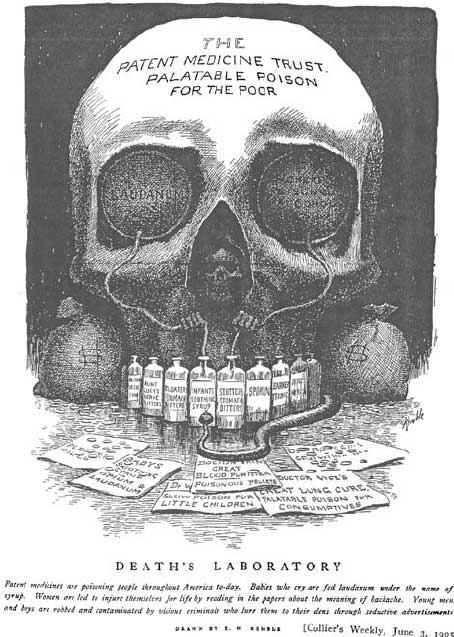
From 1906 to 1918 manufacturers could label their products with a “guarantee” that their medicine complied with the new food and drug law. The 1906 law required manufacturers to label their products if any of the following ingredients were present: alcohol, morphine, opium, cocaine, heroin, eucaine, chloroform, cannabis indica, chloral hydrate, or acetanilide. A complete listing of all ingredients was not required until 1938.
Here are some patent medicines in the museum. Visit us in-person and see these and so many more.
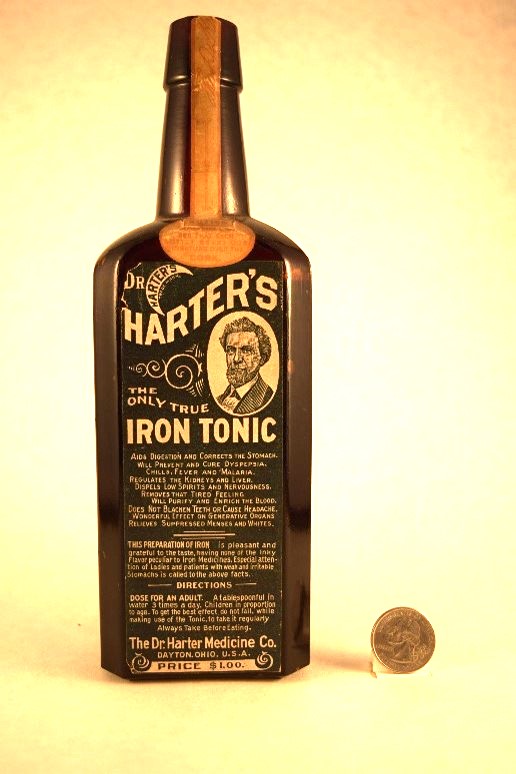
Dr Harter’s Iron Tonic was made in Dayton, Ohio from 1906-1908. The claims were Aids digestion and corrects the stomach, highly beneficial in dyspepsia, chills, fever and malaria. Regulates the kidneys and liver. Dispels low spirits and nervousness. Removes that tired feeling. Will purify and enrich the blood. Does not blacken teeth or cause headaches. Wonderful effect on generative organs. Relieves suppressed menses and whites. There are no ingredients on the label, but alcohol content was thought to be 23%.
Dr. Shoop’s Restorative made claims to be a remedy for stomach, kidneys, and heart. It is labeled “MUST AND DOES CONTAIN 12% ALCOHOL”. This product is a mixture of Nuxvomica, blood roots, hyrastis, boric acid, alcohol, water, and sugar syrup. It was guaranteed to rebuild the “inner nerves” which Dr. Shoop attributed to the drug’s effectiveness. To increase business above the door-to-door sales, Dr. Shoop decided to go into the drug stores for the real money.
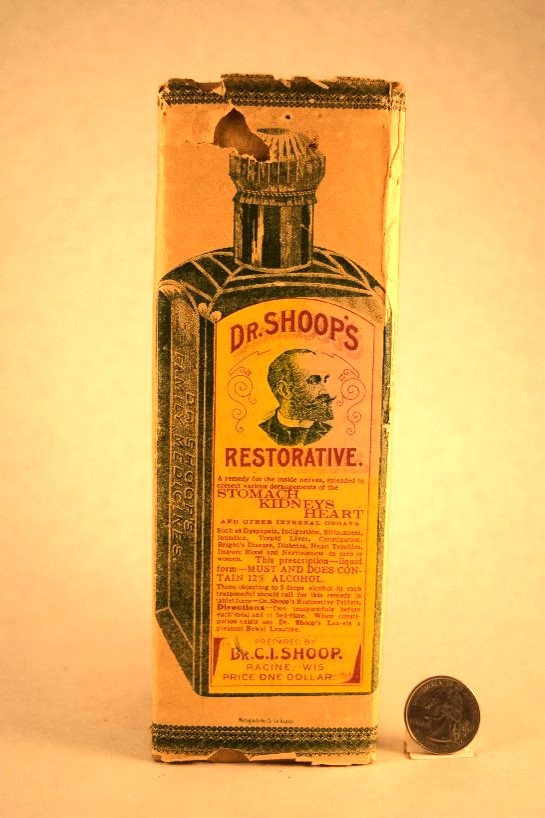

The T.A. Slocum Company, around 1906, claimed Psychine to be the “Greatest of Tonics” as stated right on the label. The indications or uses for this product as provided by the manufacturer are: Wonderful remedy for consumption and all other disorders of the throat and lungs, restorative, digestive, invigorating, sustaining. Continuously nourishes, fortifies, refreshes and strengthens the entire organism. (Consumption is an old-time word for tuberculosis). In the article The Great American Fraud, Samuel Hopkins Adams states “Psychine is about 16 per cent alcohol and has a dash of strychnine to give the patient his money’s worth”.
Pharmacy Education in the US was originally an Apprenticeship process, much like our modern trades are taught. Over time, as the complexity of medicines developed and expanded, it was necessary to create options for formal academic training. In 1821, the Philadelphia school of Pharmacy became the first school of pharmacy in the United States. Notably, Eli Lilly, founder of Eli Lilly and Company in Indianapolis attended this school. Lilly’s academic training and experience undoubtedly helped him gain a broader and deeper knowledge of Pharmacy than most of his contemporaries. Lilly utilized this knowledge to establish and grow his company very quickly.
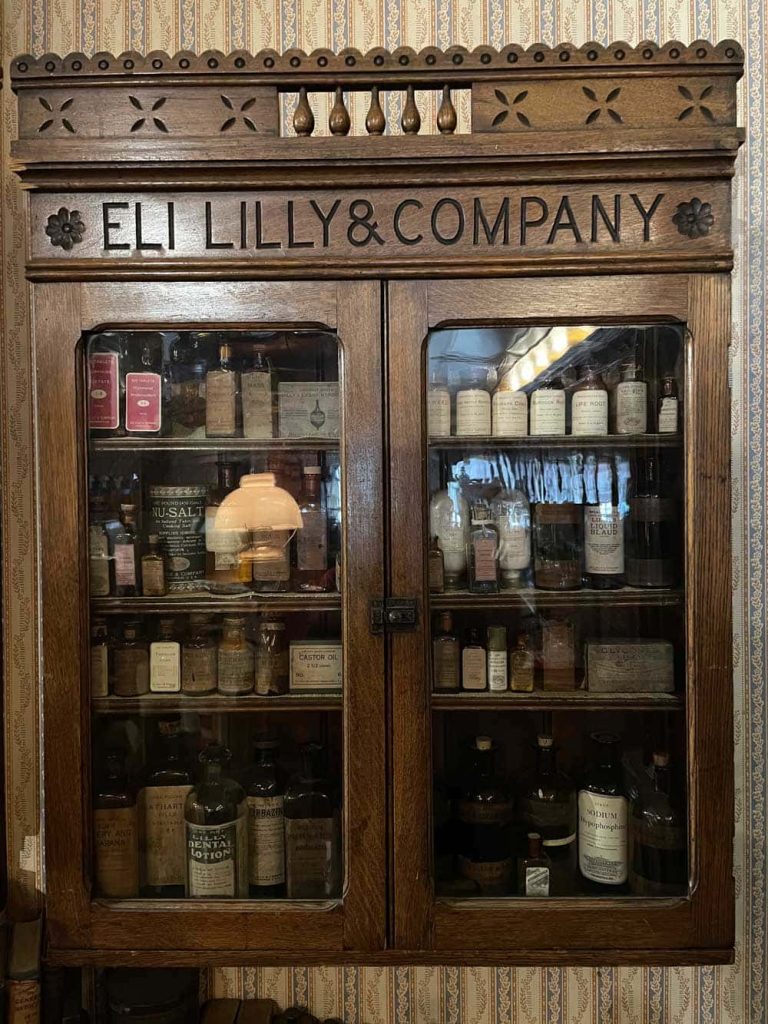
Purdue University was the first College in Indiana to offer an academic program for Pharmacy, starting in 1884. Unsurprisingly perhaps, an apprentice community Pharmacist under Eli Lilly in his early years, John N. Hurty was responsible for establishing the Purdue School of Pharmacy. From “The History of the College of Pharmacy” on Purdue’s website, we learn that John N. Hurty was able to convince then Purdue President James H. Smart to support the program. Smart required Hurty to serve as its head for at least two years. Initially, in 1884, Purdue’s School of Pharmacy was only the third State Supported Pharmacy school in the US, and began with just 7 students, and 4 faculty members.
From an Article “A Brief History of the Pharmacy College of Butler University”, by K. L. Kaufman, Dean, published in HISTORY OF SCIENCE in 1965, we learn that Butler’s school of Pharmacy has its origins in a school formed in Indianapolis in 1904, originally called “The Winona Technical Institute”. The Winona Technical Institute offered a variety of technical degrees, including Pharmacy. 12 of the 80 students in the initial 1904 class studied Pharmacy. In those years, the academic year was only 26 weeks long, and only two years of study were required for a “Pharmacy Graduate” degree. An additional 10 weeks of study in those two years allowed the student to graduate with a “Pharmaceutical Chemist” degree. In 1930, the requirement for a Pharmacy degree at the school was raised to 4 years, one of the first 10 schools in the US to adopt this new, higher standard. In 1945, The School of Pharmacy at the Winona Institute was formally brought into Butler University.
Eli Lilly also ultimately played a pivotal role in the establishment of a Pharmacy School at Manchester, the third school of Pharmacy in Indiana. A Press release from Manchester College, dated 12/20/2010 announced a $35 million dollar grant from the Lilly Endowment, to establish Indiana’s third school of Pharmacy. Today, per the Website of Manchester University, their College of Pharmacy offers a 4-year Doctor of Pharmacy degree, which requires two years of preliminary coursework.
Today’s Pharmacist is no longer your grandparents’ version of what they probably think of as a Pharmacist. It’s hard to imagine that even Pharmacists such as Bud Hook could ever picture the diverse and interesting career choices that Pharmacy graduates have today. To be fair, most everyone thinks of a Pharmacist as the busy person at the local drugstore, probably in a white coat, filling prescriptions, assisting customers, and consulting with physicians. Although many recent graduates go into retail and hospital pharmacy the career opportunities for these professionals are endless.
A Google search for “pharmacy career path” will link you to over a hundred potential job titles for Pharmacy graduates. Check out https://pharmacyforme.org/ or https://thehappypharmd.com/ for much more information. A few non-traditional Pharmacy job opportunities are listed below:
Drug Information: these Pharmacists provide educational information to healthcare professionals, consumers, and pharmaceutical personnel and may work in academic settings, managed care settings, industry, hospitals, or professional associations.
Managed Care: Pharmacists who work for health plans, Pharmacy Benefit Managers, and other managed care organizations to enhance patient outcomes while optimizing healthcare resources.
Medical science liaisons: these professionals, on behalf of a pharmaceutical company, spend most of their time consulting and advising healthcare professionals on the latest scientific data.
Regulatory: these Pharmacists oversee the regulations and guidelines that control clinical trials and various other aspects of human research.
Specialty: Pharmacists may choose to further their skills in a specialized area of medicine, anywhere from cardiology pharmacy to nuclear pharmacy to oncology pharmacy. There are presently 14 different specialty pharmacy certifications.
Veterinary: a Veterinary Pharmacist is a specially trained Pharmacist who dispenses veterinary drugs and supplies or products and advice to owners of companion animals and livestock.
Of the roughly 142 Pharmacy Schools in the United States, Indiana has three accredited such programs. While each Indiana Pharmacy school has their individual admission standards, curriculum, and unique college vibe they all are singularly minded in preparing and graduating the next generation of Pharmacists to successfully navigate the increasingly complex world of Pharmacy and more broadly, healthcare.
In 2022 Purdue University conferred 149 Pharmacists with PharmD degrees, followed by Butler with 125 and Manchester with 69. (reference 1). The PharmD degree, also known as the Doctor of Pharmacy degree, is what is granted after a 4-year professional program at any of the Indiana schools. The Doctor of Pharmacy, or PharmD, is the only degree in the United States that supports pharmacist licensure.
In addition to PharmD degrees there are many other college programs and degrees that support Pharmacy and Pharmaceutical sciences. Much more information can be found on the individual college websites.

Located in Indianapolis, Butler’s program supports both a traditional on-campus and online format PharmDs.

From its West Lafayette campus, Purdue University also offers 4-year undergraduate degree program in Pharmaceutical Sciences for training in diverse positions in industrial, academic, or other research environments.

Manchester University in Ft. Wayne offers both an onsite and online pathway to the PharmD as well as an opportunity to earn a Doctor of Pharmacy and Master of Science in Pharmacogenomics simultaneously.